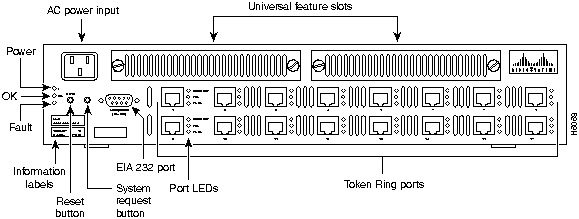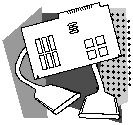|
|
This chapter provides information on the Catalyst 2600 Token Ring switch. The information is organized into the following sections:

http://www.cisco.com. For more information, see the chapter "Documentation" at the end of the catalog.
The Catalyst 2600 is a Token Ring switch that provides high-speed forwarding of frames among the segments attached to each of its ports. The Catalyst 2600 can forward frames among multiple, shared, or dedicated Token Ring LAN segments. Each of the ports on the switch can be connected to a port on any external Token Ring hub or concentrator using a customer-supplied cable. Alternatively, a Token Ring port on the Catalyst 2600 can be connected directly to a half-duplex (HDX) or full-duplex (FDX) Token Ring LAN station without an intervening Token Ring concentrator or hub.
The architecture of the Catalyst 2600 centers around the AXIS bus, a 512-Mbps switching fabric through which all switched ports communicate. To avoid the congestion problems that can occur when multiple ports communicate with a single port, each port has 512 KB of buffering, fairness algorithms, and split-buffer schemes.
To address the needs of delay-sensitive data, such as multimedia, this switching fabric contains two data queues. Frames assigned a priority of 5, 6, or 7, such as multimedia transmissions, are sent to the high-priority queue and given forwarding preference. Frames assigned a priority of 4 or lower are processed through the normal-priority queue.
To provide increased bandwidth, you can use the Catalyst 2600 to create multiple, concurrent paths among connected segments. Each path supports the full16-Mbps Token Ring bandwidth. With a parallel internal design optimized for performance, the Catalyst 2600 can forward Token Ring frames between each of the pairs of ports simultaneously and at media speeds.
The Catalyst 2600 can forward frames based on MAC address lookup. If you have source-route bridges in your network, the Catalyst 2600 can also forward frames based on the routing information field. This dual frame forwarding technique is called source-route switching.
You can select from three modes of operation for each port on the Catalyst 2600: cut-through mode, store-and-forward mode, and adaptive cut-through mode. In cut-through mode, the Catalyst 2600 begins forwarding frames as they are received; it does not wait to receive the entire packet before forwarding. This provides the benefits of dedicated-media, high-speed switching. Store-and-forward mode offers more error isolation between the segments, as the Catalyst 2600 waits until the entire frame is received and checked for errors before forwarding. Adaptive cut-through mode optimizes performance by alternating between cut-through and store-and-forward modes based on user-specified thresholds.
Figure 129 shows the front view of the Catalyst 2600. Table 261 summarizes the features of the Catalyst 2600, and Table 262 lists the environmental specifications
Figure 129 : Catalyst 2600 Front View

Table 261 : Catalyst 2600 Summary of Features
| Characteristic | Description |
|---|---|
| Ports | 16 |
| Front panel indicators | Base switch:
Port: transmit, receive, connect, full duplex System power Diagnostic Fault 2-port fiber feature card: Port: transmit, receive, connect, full duplex Ring In/Ring Out Diagnostic Fault 4-port UTP/STP feature card: Port: transmit, receive, connect, full duplex Diagnostic Fault |
| Expansion modules | 2-port fiber Token Ring, 4-port UTP/STP Token Ring |
| Buffers | 512 KB per port |
| Addresses | 1790 addresses per port; 10,000 per system |
| Protocol compatibility | Transparent to higher-level protocols |
| Network management | SNMP MIB II (RFC 1213)
Interface Table (RFC 1573) Managed Objects for Bridges (RFC 1493) IEEE 802.5 Token Ring (RFC 1231) Catalyst 2600 MIB |
| Dimensions (H x W x D) | Standalone: 3.5 x 17.3 x 14" (89 x 440 x 356 mm)
Rack-mount: 3.5 x 19 x 14" (89 x 483 x 356 mm) |
| Memory | 4 MB DRAM |
| Processor | Intel i960SA |
| Weight | 17 lbs (7.7 kg) |
Table 262 : Catalyst 2600 Environmental Specifications
| Description | Specification |
|---|---|
| Temperature | 50° to 104°F (10° to 40°C) |
| Relative humidity | 8% to 80% |
| Max wet-bulb temperature | 81°F (27°C) |
| Calorific value | 85 kcal/hr (345 Btu/hr) |
| Electrical power | 0.2 kVA |
| Capacity of exhaust | 10.6 ft/min (0.6 m/min |
| Noise level | 56 dB |
| Leakage/starting | Current 0.5 ma/40 amperes/half cycle |

The Catalyst 2600 provides the following features:
The Catalyst 2600 has 16 Token Ring ports and can support a maximum of 1790 active Token Ring MAC addresses per port. Configurations larger than 16 Token Ring LAN segments can be constructed as follows:
To aid in network management, the Catalyst 2600 also maintains status information and a variety of statistics. Status information is available for each port and for each TokenChannel, if defined. Statistics are kept by port, by domain, and for the switch as a whole.
The Catalyst 2600 also contains an Simple Network Management (SNMP) MIB-II compliant management agent that allows a customer-supplied SNMP-based network management system (such as CiscoView) to remotely monitor and control the Catalyst 2600.
In addition, the Catalyst 2600 provides switched port analyzer support, which allows you to monitor traffic on any of the Token Ring ports using a customer-supplied monitoring device such as the Network General Sniffer.
If you need to upgrade the Catalyst 2600 software, you can upgrade through the same serial port used for configuration. The code can be downloaded from a customer-supplied programmable workstation using the Xmodem protocol. Code upgrades can also be accomplished using Trivial File Transfer Protocol (TFTP).
The Catalyst 2600 Token Ring switch supports up to two expansion modules, or feature cards. The feature cards can be the following:

The Catalyst 2600 ships with a power supply, power cable, and documentation. Table 263 lists the product numbers you can use to order the Catalyst 2600 and its expansion modules. If a product number ends with an equal sign (=), the item can be ordered only as a spare. If a product number does not end with an equal sign, the item can be ordered as a spare or as a configurable part of a system order.
Table 263 : Catalyst 2600 Product Numbers
| Description | Product Numbers |
|---|---|
| 16-port Catalyst 2600 Token Ring switch | WS-C2600 |
| Catalyst 4-port UTP/STP Token Ring feature card | WS-C2600-4R |
| Catalyst 2-port Fiber Token Ring feature card | WS-C2600-2RF |
|
|
Copyright 1988-1996 © Cisco Systems Inc.